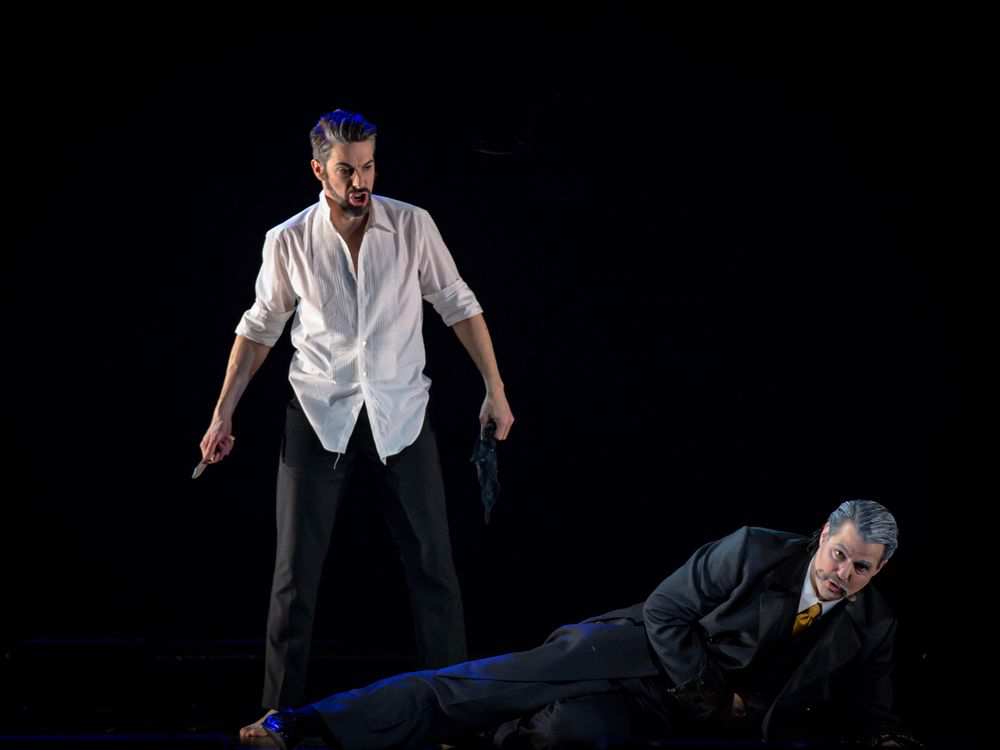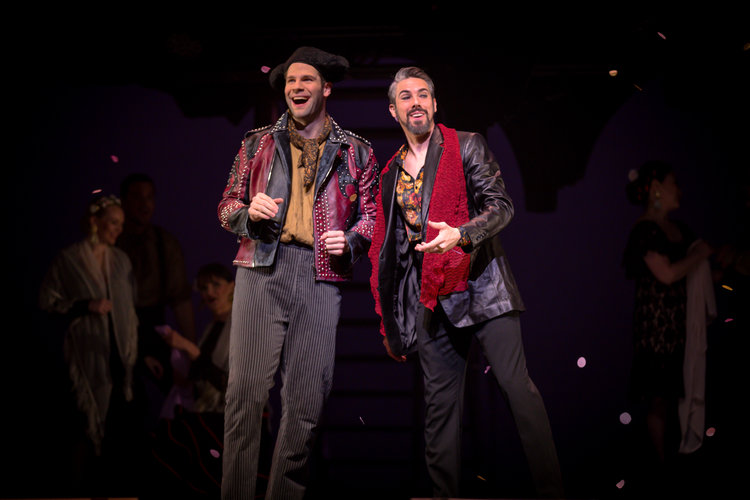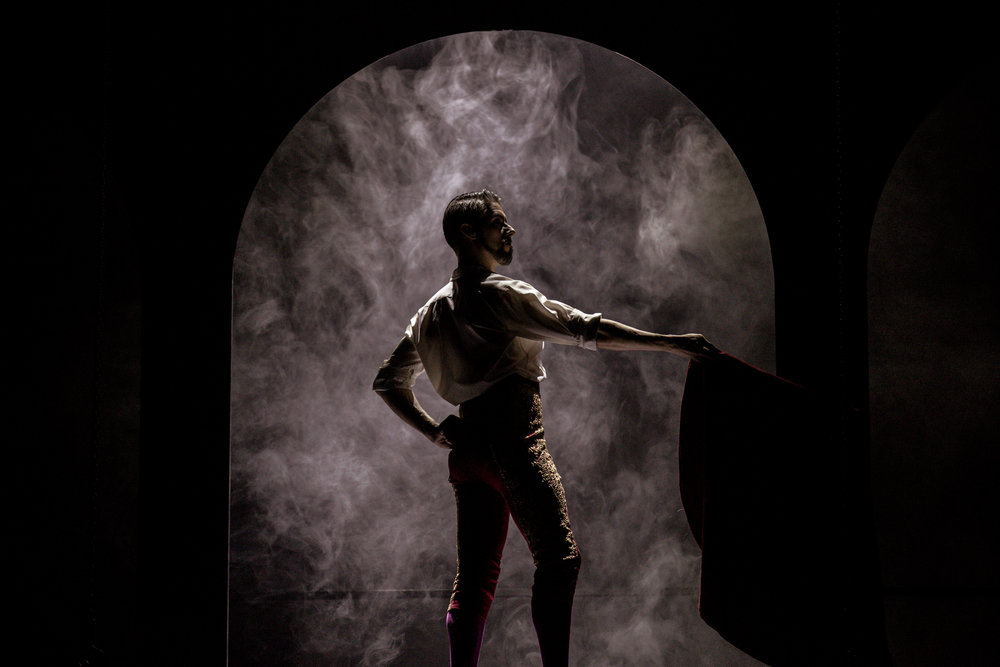It took a while to understand why the Edmonton Opera season-ending production of Mozart’s Don Giovanni was set at a grim, derelict industrial address, where menace might certainly be imagined. However, Director Oriol Tomas‘s concept was the macho world of the alpha-male matador and lady-killer, an atmosphere not immediately conjured by Bretta Gerecke’s harsh, un-Spanish-looking space. The benefit of the doubt goes to Gerecke, though, who created a world already undone from the start, ending in both physical and moral ruin as the villain was driven into the hellfire by avenging female demons adorned with horned headdresses, writhing in lugubrious glee. The staging of the first-act finale came as a cataclysmic surprise, making it clear all things are doomed for Don Giovanni, and the set finally made sense. However, the suggestion of a particularly Spanish Casanova complete with bullring in the opening tableau was unnecessary, and not really born out as the drama unfolded.

Phillip Addis (Don Giovanni) and Kirk Eichelberger (Commendatore) in Edmonton Opera’s Don Giovanni. Photo: Nanc Price
Lighting paints the drama in Edmonton Opera Don Giovanni
Deanna Finnman’s costuming was decidedly Spanish though, and the singers looked great in her designs. Lighting Designer Barry Steele deserves as much praise as Gerecke for the imaginative way he captured da Ponte’s treatment of the amoral Don’s decadent world. The subterranean, atmospheric lighting was effective throughout the production, especially during the debauchery accompanying the climactic departure of the Don into the inferno. Steele isolated each little corner of the stage where dinner guests were engaged in stylized sexual acts. Every nook held its own unique place in the sordid narrative. The overall effect was a tempered version of a Bosch-like depiction of human depravity. The red glow shading the otherwise dark space gave the scene its demimonde flavour. (Some discreet nudity at this point in the Don’s descent would not have been out of place.)
The women in this production gave consistently strong performances and conveyed their several types adeptly. Whitney Sloan (Zerlina) was especially good as the bright light in this tale of macho self-entitlement. She is a local talent who looked right at home in what was her biggest role to date. She’s had smaller responsibilities in a couple of other Edmonton Opera productions, but showed here she is ready for something more, distinguishing herself as part ingénue, part self-aware, desirable young woman. She gave a very secure performance.
Michele Capalbo an emotional Donna Anna
Soprano Michele Capalbo has a warm and powerful instrument. Her Donna Anna was the emotional foundation of this odd blend of the comic and the sinister. She conveyed the rage and sorrow of a daughter whose father had been murdered richly. Her control over her unmoored fiancé Ottavio’s fate as the lover in limbo was adamant. John Tessier, the only tenor among the male cast, always sounds sweet and clear, and his Ottavio here was no exception.
Understudy Cara McLeod, whose bio didn’t appear in the program, replaced Miriam Khalil as the vindictive, but still malleable Donna Elvira, and her performance was both theatrically and musically effective. Edmonton Opera has had luck filling roles with understudies these past two seasons. Last year, Catherine Daniel stepped into the role of Klytämnestra in Elektra at the last minute and was excellent.
Phillip Addis powerfully defiant as Don Giovanni
Baritone Phillip Addis sang the title role, and he moved between depicting a man capable of murder and rape, and slick seducer well enough. His interactions with his servant, Leporello (Erik Anstine), were a good mix of indulgence and physical threat. And in his final confrontation with the ghost of the Commendatore (Kirk Eichelberger), Addis generated a fearless defiance to create a powerful scene of male indignation and danger before he was dispatched to the furnace. Eichelberger had the requisite gravitas of an aggrieved Commendatore, and he produced an attractive, commanding bass sound with plenty of authority and resonance. Anstine’s Leporello felt careful, but he has a fine bass tone, and in the disguise scene where he pretends to be his master, he managed a little comic looseness that will doubtless increase as he sees more performances in his young career.
Edmonton Opera’s Don Giovanni was theatrically ambitious and uncompromising in its treatment of the reprehensible title character. For this production, there was no moralizing epilogue. Mozart offered both a happy and a blunt ending for the opera’s premiere productions, first in Prague and then in Vienna, where the Don just disappears into the flames, as he did in this production. The point was clear and did not need Prague’s didactic epilogue. The Edmonton audience, which was close to a full house at the Jubilee Auditorium, was more than pleased with the way this Don Giovanni fell.
The Edmonton Symphony was led by Christopher Larkin, who kept a tight rein on dynamics, giving the singers plenty of space to sing their roles. The harpsichord player, who also wasn’t listed in the program, managed the quieter accompaniment passages with commendable elegance.













